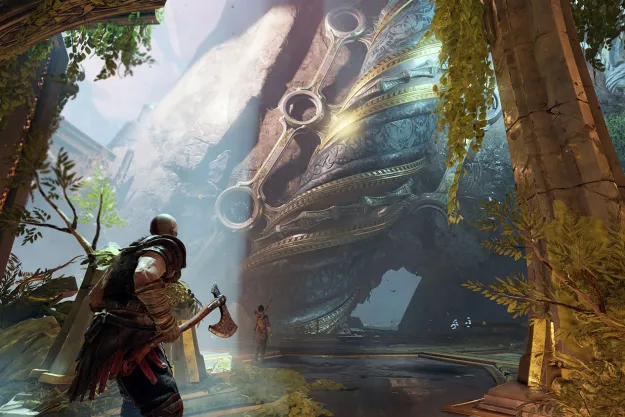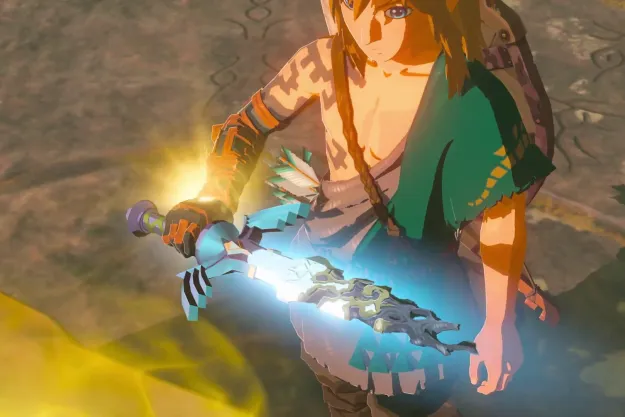
“God of War is a true blockbuster sure to impress long-time fans and newcomers alike.”
- Complex, fun combat
- Intense, nuanced story
- Beautiful visuals
- Tons to do
- Gear-based level system doesn’t really work
In the opening scene of God of War, Kratos, the god-killing rage monster, chops down a tree in silence. Standing shirtless in the snow, he breathes heavily and focuses on making solitary, deliberate strikes. He is calm, pensive, and ragged. He is immediately recognizable, but also clearly not the man you may have known.
Kratos’ new disposition in that moment summarizes the new God of War. Though it comes from the same studio, Sony Santa Monica, the PlayStation 4-exclusive sequel-slash-reboot makes sweeping changes to the franchise. The game focuses more heavily on narrative, employs a structure more akin to Metroidvania-inspired open world games like Tomb Raider and Horizon: Zero Dawn, and trades in its combo-heavy hacking and slashing for more tactical combat that can move fast or slow, but doesn’t allow care-free button mashing.
The new God of War strips the series down to its essentials and uses them to create a modern action game. It is thoughtful, both in its presentation and its mechanics. To simply say it surpasses the games that came before it would not do it justice. God of War takes a dormant franchise, one that’s worse for wear, and uses that baggage to create one of the most compelling experiences we’ve played in a long time.

Family ties
Okay, back to the tree.
God of War opens on a sad note — Kratos’ wife has died. Having killed most of his kin in the Greek pantheon in the original God of War trilogy, he’s retired in solitude to the land of the Norse gods. He married, had a son – Atreus — and intended to live a quiet life. Now, to respect his wife’s wishes, he and Atreus must climb the highest peak in the Norse world to spread her ashes.
To respect his late wife’s wishes, Kratos and his son, Atreus, must climb the highest peak in the Norse world to spread her ashes.
For Kratos, the physical journey is not the most daunting aspect of the deed. Though he’s calmed considerably since his god-killing days, Kratos has not been the most outwardly caring or present father. He clearly loves his son, but doesn’t know how to be supportive in this extremely trying time. As they set out on the journey, Kratos tries to bond with him by teaching Atreus what he knows: How to hunt, kill, and survive.
Some have jokingly referred to this game as “Dad of War,” because of Atreus’ prominent presence and Kratos’ new bearded look. Though the duo does more than their fair share of monster-slaying, each character is more concerned with the other’s survival than the demise of their enemies. Kratos, now a single parent, wants to find a way to connect with his son in spite of his deeply ingrained stoicism. Atreus, bright eyed and curious, wants to learn more about the world and the man he calls “father.” God of War is more a journey of self-discovery than conquest.
Kratos and Atreus only have each other to talk to, so they are constantly in conversation. They pause in combat, but as you roam the world, they are getting to know each other, and you are getting to know them. It’s as if you are walking those paths with them, and bonding in your own way as the game goes on.
The experience is buoyed by stellar writing and voice acting that cuts deep to the heart of Kratos and Atreus’ awkward relationship. Between Kratos, the human blunt object, and Atreus, the grieving child, misunderstandings are inevitable. Seeing them try and fail, and fail, but eventually learn to be better to each other, feels meaningful and rewarding, even if you don’t have much to do with it.
The places you’ll go
Where past God of War games offered a winding but ultimately linear journey, this game employs a hub-and-spoke, “Metroidvania” structure that takes a step towards an open-world experience, but generally keeps you on a tight, direct path. Once you reach a certain point, you’ll have the ability to explore a large open space, which features plenty of optional areas to explore, and also serves as a hub from which you can trek to new areas.
From scaling and/or slaying giant beasts, to surveying magnificent vistas, God of War has not lost its sense of spectacle.
You’ll want to explore. It’s always exciting to find something new in God of War. While much of the last God of War trilogy was set almost exclusively against a Greek city motif, God of War features many kinds of environments, from caves and forests to destroyed temples and cities. The world is colorful and vibrant, and there always seems to be something new and exciting to see. There are also, of course, amazing set pieces around every corner. From scaling and/or slaying giant beasts, to surveying magnificent vistas, God of War has not lost its sense of spectacle.
The price of that spectacle is freedom. While you can visit many areas once the game kicks into high gear, most of the game’s missions take place in linear zones that convey the illusion of free movement, using winding paths and shortcuts that loop back to previous areas. They give you the impression that areas twist and turn to make you forget, at least for a moment, that the path always brings you forward.
The game hews you to that path through liberal use of “gear-gating,” or closing off paths using different kinds of locks that you’ll find the keys for as your progress through the story. Unlike many games that use this mechanic — again, the modern Tomb Raider games spring to mind — God of War links a decent number of these mechanics to puzzles, both optional and mandatory.

Opening locked doors and chests often requires a little bit of forethought. They rarely take long to figure out, but they are complex enough to make you shift your mind away from combat strategy to a puzzle-solving mindset, which prevents any one type of activity from feeling to monotonous.
It doesn’t hurt that the game’s twists and turns are consistently packed with tons of bits of loot and lore. There are chests and collectible items hidden in every little corner of the world. Much of it is fodder for Kratos’ progression, either in the form of hacksilver and crafting items you’ll use to craft new armor, or special items that increase your health and “rage” meters. There are lots of other collectibles and activities to complete too, although some are mostly busywork — like tracking down all of Odin’s glowing green ravens, for instance.
A fight to the death
While the game’s story is emotional and well-integrated into much of the game, it is still separate from the “meat” of the gameplay which is, of course, combat. You will spend more time fighting than doing anything else in God of War. Luckily, fighting is engaging and varied, even when you’re fighting the same enemies over and over.
The new God of War is deliberate and vicious. Rather than fighting dozens of easily dispatched enemies, each opponent can kill you if you don’t take the fight seriously.
Previous games in the franchise were frantic kill-fests, but the new God of War is deliberate and vicious. Rather than fighting dozens of easily dispatched enemies, each opponent can kill you if you don’t take the fight seriously. It isn’t as challenging as Dark Souls or Bloodborne, but you will need to strike strategically, dodge effectively, and have a strong command of your increasingly large and nuanced set of attacks to survive.
Kratos new weapon is suited to this kind of fighting. When he settled in Midgard, Kratos put away his chain-linked Blades of Chaos, so he leaves home carrying the ice-imbued Leviathan Axe. That means no more wide, sweeping attacks that hit every nearby enemy. Kratos’ attacks cover a short distance, but can chain together for some interesting juggling combos.
Over time, Kratos accrues experience, which you can put into new skills. This adds powerful effects to specific combos and creates new attack options, such as a charged strike, and extra contextual skills for running attacks.
To hit enemies from a distance Kratos can also throw the axe, freezing any enemy it hits. When the axe is out of hand you can fight unarmed, which does less damage, but has other advantages. Once thrown, you can magically recall it with the press of a button. The axe is almost as deadly on the way back as it is on way forward, and there are a lot of neat ways to play with throwing the axe — either at enemy or a spot on a wall — then repositioning yourself before recalling it.
Executions return from the original trilogy, albeit in a more strategic form. As you hit your enemies repeatedly in rapid succession, you build “stun” damage until, eventually, you gain the ability to grab your opponent and do either heavy damage or kill them instantly.
Knowing how to use all the unique and contextual variations on attacks becomes important as the game goes on and you are tasked with fighting large numbers of enemies. The camera never opens up from its tight, over-the-shoulder position, so you must be wary of enemies trying to flank you.
It sounds like a pain but, when you get into the swing of things, winning a battle against four or five enemies is possible – and often feels like a true accomplishment.
Atreus is always there to help as well. Kratos’ son fights in every battle, and he makes himself very useful. Mechanically, Atreus acts more as an extension of skill set than a second character. While he runs around and attacks enemies if left to own devices, keeping them off your back, you can give him useful commands. You can use him to stun enemies during powerful attacks, or keep opponents off your back.
Interestingly, Atreus becomes a more effective combat partner as the game progresses. There are both narrative and mechanical explanations for this. On the story front, Atreus starts doing more in battles as he becomes more accustomed to fighting. Mechanically, as you get further into the game, you are forced to fight larger and larger groups of enemies, which is where his supplementary abilities help most. It’s a light touch that connects Atreus’ personal growth to gameplay in a rare, insightful way.
Pobody’s Nerfect
For everything good about God of War, the game is not without its flaws. The game’s greatest issues, we found, were with its armor-based leveling system.
Kratos earns a gear level based on the average power of his four pieces of armor — chest, gauntlets, waist, and a talisman. The approach, which recalls Destiny 2 and Assassin’s Creed Origins, is fine at a glance, but the game relies on the difference between your total level and your opponents’ to determine how much damage you can give and take.
The gear level, which seems to operate apart from stats and override them at times, can negate everything that’s great about the game’s combat mechanics. You will run into situations, especially in optional content, where you’ll be staring down enemies with two to three gear levels on you. No matter how good you are, you won’t be able to defeat them. Grinding is a thing in God of War, and while it’s not common enough to be a major issue, it does occasionally annoy.
We also grew weary of the story. As fascinating as the lore can be, the game spends a lot of time building towards anti-climactic confrontations. There are a ton of bosses along the way that are just color-swapped version of past bosses, and it’s all made worse by a final act that doesn’t know when to end.
Our Take
God of War balances storytelling and combat-heavy gameplay better than any other game of its type. The constant interplay between its emotional journey and its ragged, demanding combat draws you in and forces you engage with both elements in a way that brings new meaning to both. It’s a true blockbuster that’s sure to impress both long-time franchise fans and newcomers.
Is there a better alternative?
There are so, so many narrative-drive open-world action games that what you’d prefer may come down to the game’s narrative themes. God of War is certainly one of the best games in the genre, but you may be more drawn to science-fantasy of last year’s Horizon: Zero Dawn, or the medieval fantasy of The Witcher III.
How long will it last?
Our God of War playthrough took approximately 40 hours, including most, but not all, of the game’s optional story missions. Following the playthrough, we played additional five hours of side content.
Considering that many of the areas we did not complete include some of the game’s most challenging optional battles, we estimate that most players will need somewhere between 50-60 hours to wring every bit of content in the game.
Should you buy it?
Yes. Unless you are actively tired of open-world action games, or games with an abundance of violence, you will want to play God of War.
God of War was reviewed on a PlayStation 4 using a retail code provided by the publisher.
Editors' Recommendations
- PS5 Pro: news, rumored release date, price, and specs
- The best games on PlayStation Plus, Extra, and Premium
- PlayStation 6: release date speculation, price, specs, and more
- PS4 vs. PS5: which console should you buy in 2024?
- PlayStation lays off 900 people and shuts down London Studio






